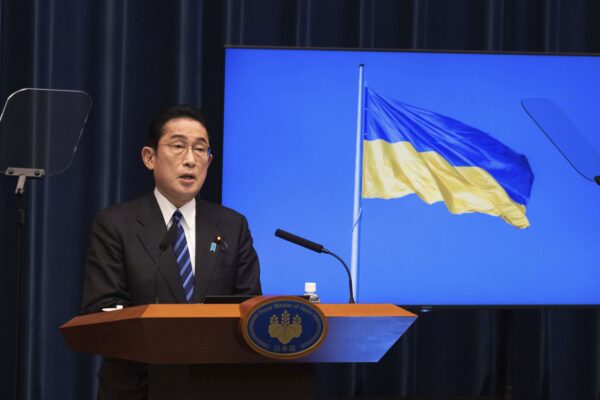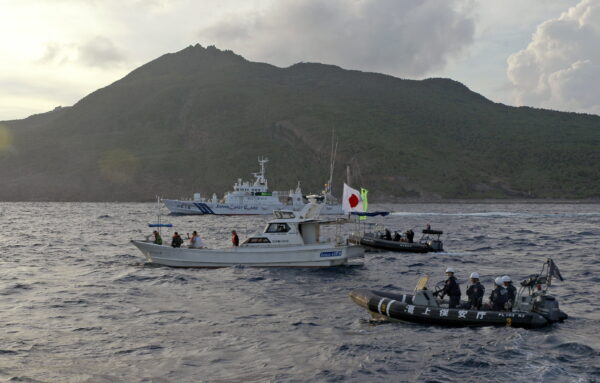Japan Signs Contracts With Mitsubishi to Mass-Produce Long-Range Missiles Amid China Threat
Japan on April 11 signed contracts with Mitsubishi Heavy Industries, the nation’s top defense contractor, to develop and mass-produce long-range missiles as the country seeks to acquire “counterstrike capabilities” amid communist China’s growing military threats. Japan’s Defense Ministry awarded Mitsubishi with four contracts worth 378 billion yen ($2.8 billion), including mass production of ground-launched Type 12 guided missiles and a hypersonic ballistic missile. Mitsubishi also will develop enhanced versions of Type 12 guided missiles that can be launched from land, aircraft, and ships. Janes reported that the new missiles will have a range of up to 621 miles. While the deployment of these weapons has been scheduled for 2026 and 2027, according to the ministry’s statement, it didn’t specify the number of missiles that Japan intends to deploy. The move is aligned with the National Security Strategy released last year, which includes acquiring counterstrike capabilities to bolster defense amid regional security challenges from China, North Korea, and Russia. In February, Defense Minister Yasukazu Hamada said Japan would bulk-order Tomahawk cruise missiles from the United States that are capable of striking targets as far as 621 miles away. Hamada didn’t specify how many missiles Japan intends to buy, but local media reports state that Japan wants 500 missiles. Military Threats The move to acquire counterstrike capabilities is widely seen as a departure from Japan’s post-war constitution, which renounces war or the use of force in settling international disputes. However, Prime Minister Fumio Kishida has said that Japan would maintain its exclusively defense-oriented policy, which states that defensive forces can only be used in the event of an attack. “We have written in detail the counterattack capabilities that we have decided to possess, including their definition and the circumstances under which they can be used, in the National Security Strategy,” Kishida told reporters on Dec. 16, 2022. Japanese Prime Minister Fumio Kishida speaks during his press conference in Tokyo on Feb. 24, 2023. (Stanislav Kogiku/Pool Photo via AP) Kishida said he’s concerned that what happened in Ukraine may happen in East Asia in the future and that Japan should be prepared to face any emergency arising because of countries who “trample” on the peace and security of other countries. Without naming China, he said international law isn’t being followed in the South China Sea, while in the East China Sea, where Japan is located, there are increased attempts to change the status quo by force. Peace across the Taiwan Strait has also been threatened, he said. Kishida had also urged the government to increase defense spending to 2 percent of its gross domestic product to bolster the country’s military capabilities. Japan–China Military Hotline Japan and China have established a direct military hotline to prevent maritime and air clashes as tensions grow over competing territorial claims in the East China Sea. Japanese coast guard vessel and boats (rear and right) sail alongside Japanese activists’ fishing boat (center) near a group of disputed islands called Diaoyu by China and Senkaku by Japan on Aug. 18, 2013. (Emily Wang/AP Photo) “We will utilize it not only for responding when unforeseen circumstances occur but also for building trust between the two countries,” the Japanese Defense Ministry stated. Local media reported that the line would soon be operational and would link the leadership of Japan’s Self-Defense Forces at the nation’s Defense Ministry with Chinese Defense Ministry officials. Disputed islands—called Senkaku by Japan and Diaoyu by China—in the East China Sea have long been a source of friction between the two countries. The Chinese regime claims the uninhabited islands as its territory. Over the years, Japan has protested repeated intrusions by Chinese vessels in the area, which are under Japanese control. Venus Upadhayaya and Reuters contributed to this report.

Japan on April 11 signed contracts with Mitsubishi Heavy Industries, the nation’s top defense contractor, to develop and mass-produce long-range missiles as the country seeks to acquire “counterstrike capabilities” amid communist China’s growing military threats.
Japan’s Defense Ministry awarded Mitsubishi with four contracts worth 378 billion yen ($2.8 billion), including mass production of ground-launched Type 12 guided missiles and a hypersonic ballistic missile.
Mitsubishi also will develop enhanced versions of Type 12 guided missiles that can be launched from land, aircraft, and ships. Janes reported that the new missiles will have a range of up to 621 miles.
While the deployment of these weapons has been scheduled for 2026 and 2027, according to the ministry’s statement, it didn’t specify the number of missiles that Japan intends to deploy.
The move is aligned with the National Security Strategy released last year, which includes acquiring counterstrike capabilities to bolster defense amid regional security challenges from China, North Korea, and Russia.
In February, Defense Minister Yasukazu Hamada said Japan would bulk-order Tomahawk cruise missiles from the United States that are capable of striking targets as far as 621 miles away.
Hamada didn’t specify how many missiles Japan intends to buy, but local media reports state that Japan wants 500 missiles.
Military Threats
The move to acquire counterstrike capabilities is widely seen as a departure from Japan’s post-war constitution, which renounces war or the use of force in settling international disputes.
However, Prime Minister Fumio Kishida has said that Japan would maintain its exclusively defense-oriented policy, which states that defensive forces can only be used in the event of an attack.
“We have written in detail the counterattack capabilities that we have decided to possess, including their definition and the circumstances under which they can be used, in the National Security Strategy,” Kishida told reporters on Dec. 16, 2022.

Kishida said he’s concerned that what happened in Ukraine may happen in East Asia in the future and that Japan should be prepared to face any emergency arising because of countries who “trample” on the peace and security of other countries.
Without naming China, he said international law isn’t being followed in the South China Sea, while in the East China Sea, where Japan is located, there are increased attempts to change the status quo by force. Peace across the Taiwan Strait has also been threatened, he said.
Kishida had also urged the government to increase defense spending to 2 percent of its gross domestic product to bolster the country’s military capabilities.
Japan–China Military Hotline
Japan and China have established a direct military hotline to prevent maritime and air clashes as tensions grow over competing territorial claims in the East China Sea.

“We will utilize it not only for responding when unforeseen circumstances occur but also for building trust between the two countries,” the Japanese Defense Ministry stated.
Local media reported that the line would soon be operational and would link the leadership of Japan’s Self-Defense Forces at the nation’s Defense Ministry with Chinese Defense Ministry officials.
Disputed islands—called Senkaku by Japan and Diaoyu by China—in the East China Sea have long been a source of friction between the two countries. The Chinese regime claims the uninhabited islands as its territory. Over the years, Japan has protested repeated intrusions by Chinese vessels in the area, which are under Japanese control.
Venus Upadhayaya and Reuters contributed to this report.












